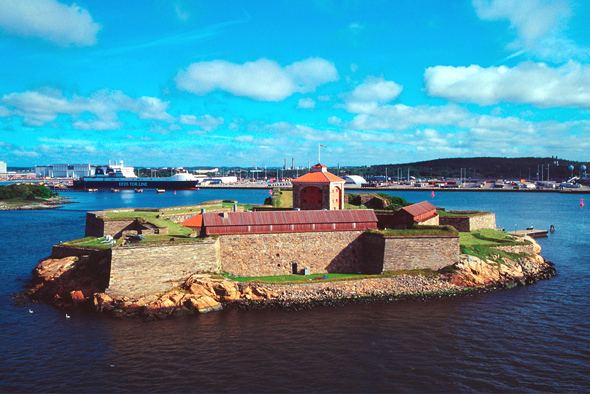Type Sea fortress Built 1653 (1653)–1701 Materials Granite, brick Phone +46 31 15 81 51 | Open to
the public Yes In use 1676–1869 Address 413 01 Gothenburg, Sweden | |
 | ||
Similar Oscar II fort, Sjömaga, Långedra Värdshus AB, River Restaurant On The Pi, Skansen Kronan | ||
The new lvsborg fortress
Älvsborg (also Elfsborg Fortress) is a large sea fortress in Rivö fjord within modern Gothenburg, Sweden. Situated at the mouth of the Göta River, it protected medieval Sweden's only access to the North Sea and the Atlantic Ocean, along with the nearby settlement known today as Gothenburg (formerly named Lödöse, Nya Lödöse, Älvsborg and Charles IX's Gothenburg).
Contents
- The new lvsborg fortress
- Crazy swede lvsborg fortress g teborg
- Old lvsborg Fortress
- New lvsborg Fortress
- References
The original Old Älvsborg Fortress (Swedish: Älvsborgs fästning or Älvsborgs slott) was located on the mainland, on the southern shore of the estuary, above modern Klippan. Only few ruins are visible today in the vicinity of the Carnegie-pier.
The old fortress was dismantled and relocated to one of the islands in the estuary, in the 17th century. This New Älvsborg Fortress (Swedish: Nya Elfsborg) is still maintained.
In 1643, a settlement in New Sweden, North America, was named Fort Nya Elfsborg ("Fort New Älvsborg"), after the Swedish fortress. This settlement was abandoned in 1655. Gothenburg was the main centre for Swedes emigrating to America, and the fortress would have been one of the last sights the emigrants saw on leaving the country.
Crazy swede lvsborg fortress g teborg
Old Älvsborg Fortress
In medieval Sweden, Älvsborg was the country's only access to the North Sea. Bohuslän, the area north of Älvsborg, was part of Norway until 1658; Halland, the region to the south, was part of Denmark until 1645. Sweden's only Atlantic settlement, Lödöse, built about 1200, (known as "Gothenburg 1") was the first settlement located at the mouth of the Göta Älv. It was followed by New Lödöse ("Gothenburg 2") located near the modern town.
In 1473, New Lödöse was granted substantial privileges. The Old Älvsborg Fortress was built in the 14th century, located at the Klippan area near what is now the harbour entrance of Gothenburg. After the Danes easily conquered the fortress several times, fortification works was gradually expanded. New Lödöse was burned down by Danish forces in 1521, and after it was initially rebuilt at the same spot in 1526, it was later relocated ("Gothenburg 3") near the Älvsborg fortress, west of the modern town.
In 1563, when the Northern Seven Years' War broke out, the Swedish burned the town themselves to prevent Denmark from capturing it, and Denmark took control of Älvsborg Fortress. The war ended with the Treaty of Stettin (1570), which obliged Sweden to pay 150,000 riksdaler to ransom the fortress of Älvsborg. To pay this extraordinarily high amount of money, Sweden heavily taxed all moveables in the country, resulting in further impoverishment of the war-torn population. Unburned towns had to pay one twelfth, peasants one tenth, burned down towns one eighteenth of their properties' value. In 1603, the adjacent town ("Gothenburg 4") was again relocated to the site of the channel opposite Älvsborg Fortress. Built by Charles IX of Sweden, it was the first town named "Göteborg". The town was annilihated by Denmark in 1611, who retained possession of Älvsborg between 1612 and 1619.
Today, only a few ruins of the fortress are preserved under a canopy to minimize further deterioration at 57°41′23″N 11°54′26″E.
New Älvsborg Fortress
New Älvsborg Fortress was built in the 17th century near the ruins of the old fortress, but on a small island where the Göta Älv river meets the sea. It protected the new town of Gothenburg, founded in 1621 by Gustavus Adolphus of Sweden. New Älvsborg Fortress today is a listed building (byggnadsminne) and a popular tourist attraction.
